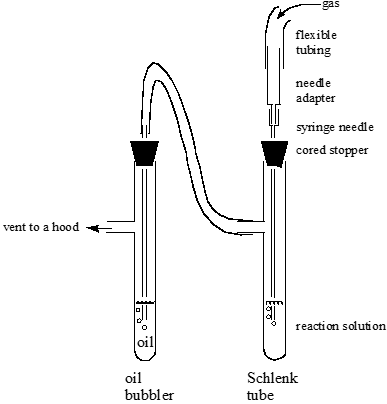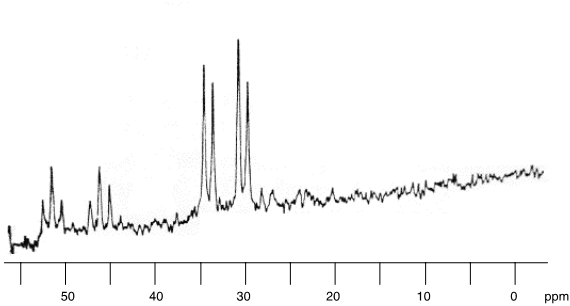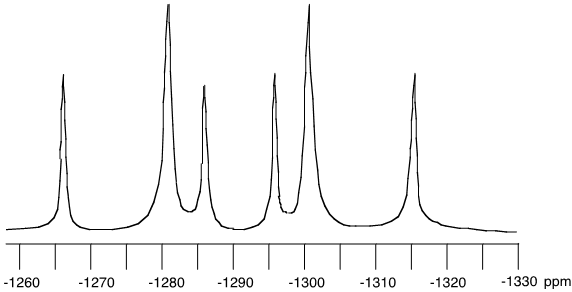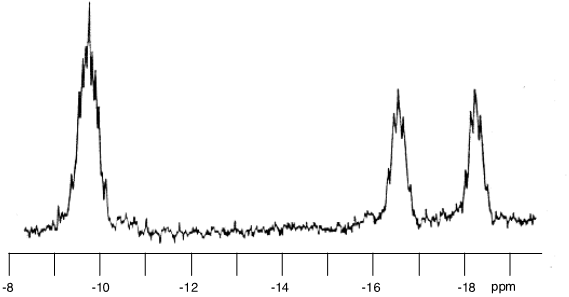Part B: Homogeneously-Catalyzed Hydrogenation of an Alkene
- Page ID
- 127284
You will hydrogenate two samples of cyclohexene. For the first sample, you will follow this procedure:
Place 10 mL of toluene and a stir bar into a Schlenk tube which is attached to an oil bubbler (see the Figure below). Degas the solvent by bubbling hydrogen through it for 10 min. With the H2 still flowing, add 25 mg of RhCl(PPh3)3 (you will have to temporarily remove the septum). Stir vigorously until the catalyst is dissolved. Slowly add 1 mL of freshly distilled cyclohexene using a 1 mL calibrated pipet. Note the time the cyclohexene was added. Continue the vigorous stirring and H2 flow, making sure that the needle tip is almost touching the stir bar. After 20 minutes take a tiny sample of the solution and analyze it by GC (note the time the sample was taken). Continue the hydrogen bubbling through the remaining solution. After the solution has turned completely yellow (and at least 30 minutes after your previous sample was taken), stop the H2 supply and the stirring, note the time again, and analyze the solution again. Report all color changes during the reaction.
Analyze the solutions by gas chromatography (the TA will instruct you on the proper conditions).
Pour the solutions into the bottle in the fume hood labeled "rhodium for recycling."
For the second sample, you will modify the procedure in one of the following ways.
a) Use double the quantity of catalyst precursor, or
b) Use double the quantity of cyclohexene, or
c) Add 1 mL of an alcohol, or
d) Add 1 mL of an amine, or
e) Add 80 mg of PPh3.
For GC samples. A ~100 times dilution is needed for best results. Dilute 1 drop of toluene solution from Schlenk tube with 2mL acetone. Put the diluted solution into GC vials with a syringe with a filter! (4 GC vials and 4 filters are need for each group.)
Choose only one of these options. Make sure that you have not chosen the same option as the other group(s) doing this experiment today.
You may perform the hydrogenation of the second sample of cyclohexene simultaneously with the first sample, or with a gas splitter. You will need to confirm that the alcohol or amine, if you use them, do not have similar retention times to cyclohexane or cyclohexene. If the retention times are similar, then you will have to choose a different alcohol or amine. 
Figure: How to bubble a gas through a solution of an air sensitive compound.
Calculations:
First calculate the % conversion of cyclohexene to cyclohexane.

Assuming there has been no loss of material, then:

where “moles alkane” and “moles alkene” refer to the quantities of these species present at the time the sample was injected into the GC.
Because the areas of the alkane and alkene peaks are proportional to the number of moles of alkane and alkene:
area of alkane peak = Calkane ´ nalkane
area of alkene peak = Calkene ´ nalkene
Assuming that the proportionality constants C (called “calibration constants”) are equal, then:

Based upon the GC trace for the sample taken after 20 minutes, calculate the % conversion of the cyclohexene from the integration of the GC peaks. Using the % conversion and the original number of moles of cyclohexene, calculate how many moles of cyclohexane were produced. From that answer, determine the TON and TOF. Repeat these calculations for the sample which had a longer time to react.


Waste disposal
Solutions potentially containing rhodium are not waste. Similarly the products, after they have been analyzed and graded, are not waste. The solutions and products should be placed into the bottle in the fume hood labeled "rhodium for recycling."
All clean organic solvents, containing no metals or corrosive compounds, should be collected in the organic waste container. All waste triphenylphosphine must be disposed of in the Experiment H waste container.
Problems
1. The 31P{1H} NMR and 103Rh NMR spectra of RhCl(PPh3)3 in CD2Cl2 are shown in Figures 1 and 2. Using splitting trees, explain the observed coupling. Compare the 31P{1H} NMR spectrum shown below to the one you acquired. If they are different, explain why (you may ask your TA to help you on this last point).
2. If you bubble H2 through a solution of RhCl(PPh3)3 in CD2Cl2, you get a pale yellow solution which has the 1H and 31P{1H} NMR spectra shown in Figures 3 and 4. Using splitting trees, explain the observed coupling (for the 1H spectrum, don’t try to explain the fine structure on the hydride peaks; the resolution is insufficient to resolve the details). What is the formula and structure of the product? Would you get this pattern with any isomer of the product? Compare the 1H NMR chemical shift of the hydride ligands in this complex to the chemical shift of pure H2 gas in solution (4.6 ppm in CD2Cl2). Explain the difference in the chemical shifts in terms of the bonding in the complex.
3. When 31P NMR spectra are obtained, proton decoupling is used. Why? What would the 31P NMR spectrum of a simple phosphine (such as P(CH3)3) look like with and without proton decoupling?
4. The area under a peak in a gas chromatogram depends on the amount of compound present and the response of the detector to that compound. A Flame Ionization Detector (FID) burns the compound as it comes out of the column, and detects it by measuring the conductivity of the flame. We have neglected the possibility that cyclohexene and cyclohexane may have different responses. How could one correct for this problem? Why isn't it necessary in our experiment?
5. Compare the conversions, TONs and TOFs for the two samples and the two reaction times. How did conversion, TON and TOF vary with time? How did the “altered procedure” affect conversion, TON, and TOF. Speculate on a reason for any changes observed.
6. If you were asked, as part of a research project, to optimize the rate of hydrogenation of cyclohexene, what parameters or conditions would you adjust? Describe why each parameter could potentially increase the hydrogenation rate.
Spectra
1. Acquire the 31P{1H}NMR spectrum of your sample of RhCl(PPh3)3.

Figure 1. The 31P{1H} NMR spectrum of RhCl(PPh3)3 in CD2Cl2. (Heaton et al., J. Chem. Soc., Dalton Trans. (1992), 2533)

Figure 2.. A simulation of the 103Rh NMR spectrum of RhCl(PPh3)3 (1 ppm = 9.45 Hz) based on published data. (data from T. H. Brown and P. J. Green., J. Am. Chem. Soc., (1969) 91, 3378, and T. H. Brown and P. J. Green., J. Am. Chem. Soc., (1970) 92, 2359

Figure 3. The 1H NMR spectrum of the compound obtained by bubbling H2 gas through a solution of RhCl(PPh3)3 in CD2Cl2.(Heaton et al., J. Chem. Soc., Dalton Trans. (1992), 2533)

Figure 4. The 31P{1H} NMR spectrum of the compound obtained by bubbling H2 gas through a solution of RhCl(PPh3)3 in CD2Cl2. Note that a small amount of RhCl(PPh3)3 remains in solution. (Heaton et al., J. Chem. Soc., Dalton Trans. (1992), 2533)

